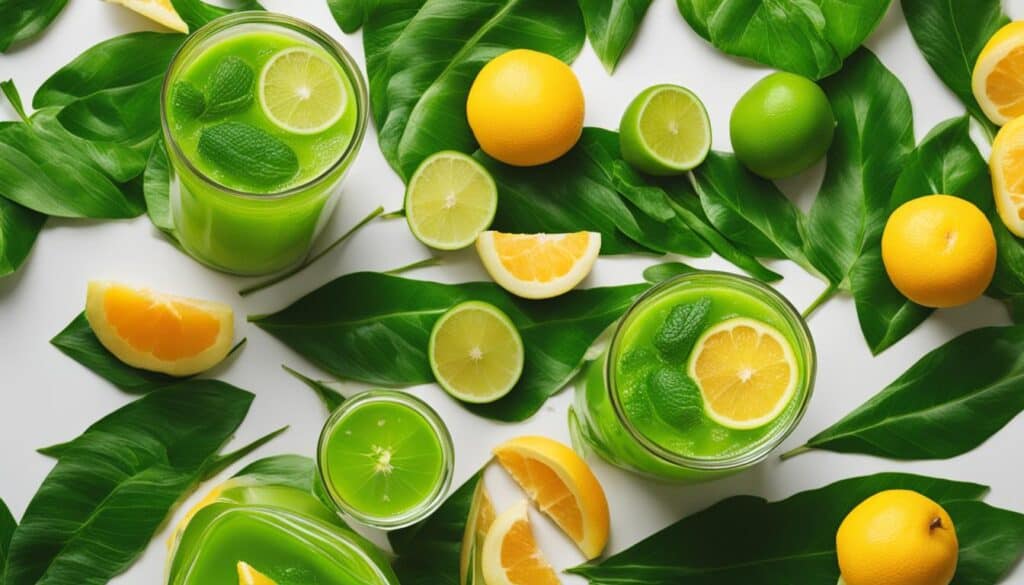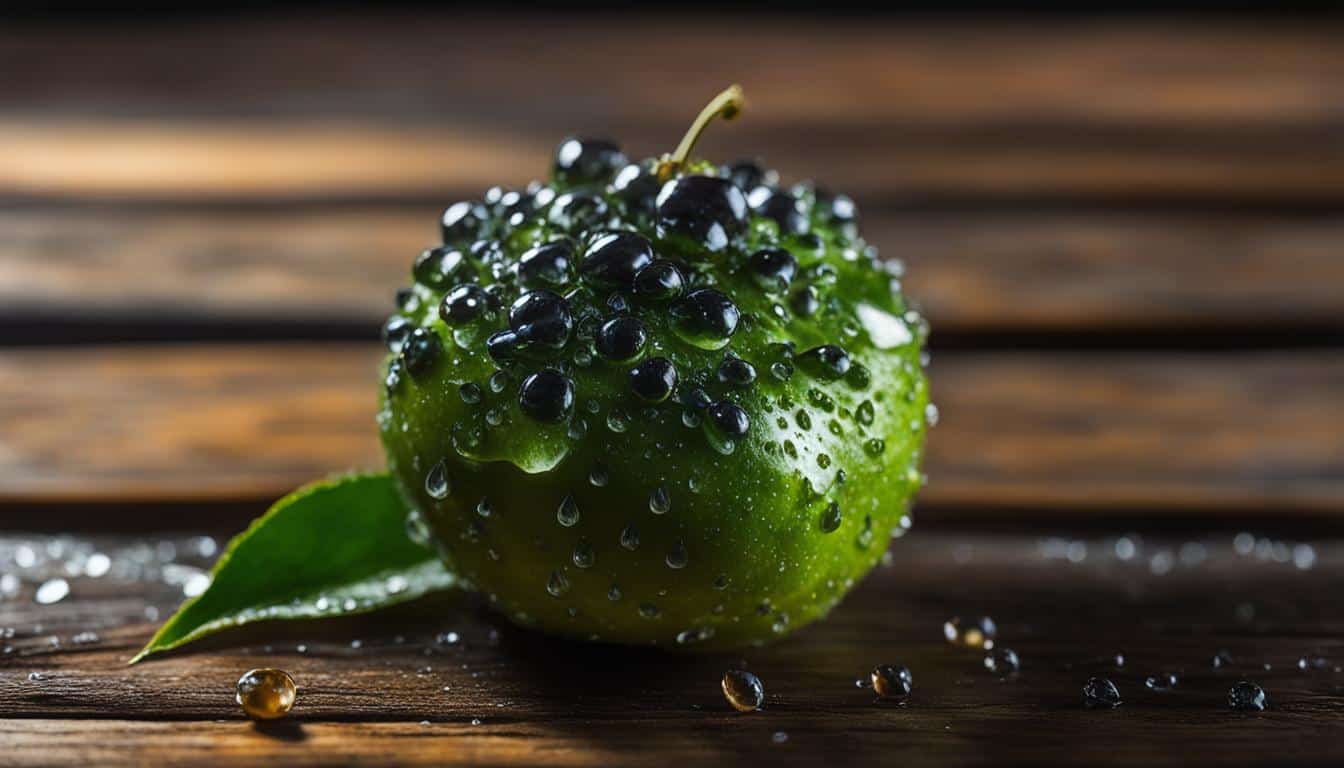Welcome to my article on sudachi, the fascinating Japanese citrus fruit that is sure to tantalize your taste buds and bring a burst of flavor to your culinary creations. From its unique tart and tangy taste to its vibrant green color, sudachi is a versatile ingredient that adds a delightful twist to dishes of all kinds. Whether you’re a seasoned chef or a home cook looking to explore new flavors, sudachi is a must-try ingredient that will take your dishes to the next level.
Join me as I delve into the world of sudachi, exploring its flavor profile, its role in Japanese cuisine, its health benefits, and its various culinary uses. I’ll also provide tips on how to cultivate sudachi and suggest some substitutes if you can’t find this gem of a fruit. To top it all off, I’ll share some mouthwatering sudachi recipes that will inspire you to unleash your creativity in the kitchen.
Key Takeaways:
- Sudachi is a type of Japanese citrus fruit known for its tart and tangy taste.
- It is highly valued in Japanese cuisine and adds a vibrant touch to dishes.
- Sudachi is rich in vitamin C and other beneficial nutrients.
- It can be used in a wide range of culinary applications, from traditional Japanese dishes to cocktails and dressings.
- If you can’t find sudachi, you can try substitutes like yuzu, lime, or lemon.
The Flavorful Characteristics of Sudachi
Sudachi, with its tangy taste, citrusy aroma, zesty flavor, and bright acidity, offers a unique and delightful culinary experience. Its distinct flavor profile sets it apart from other citrus fruits, making it a favorite among chefs and food enthusiasts.
The juice of sudachi has a strong zesty flavor that invigorates the taste buds and enhances the overall flavor of a dish. Its tangy and citrusy taste adds a refreshing kick, while the bright acidity cuts through the richness of dishes, creating a perfect balance of flavors. The aroma of sudachi is also enticingly citrusy, adding a delightful fragrance to any recipe.
Whether you’re using sudachi in traditional Japanese dishes, cocktails, or dressings, its flavorful characteristics add a vibrant and exciting twist to your culinary creations.
The Flavorful Characteristics of Sudachi Table
Here is a table summarizing the flavorful characteristics of sudachi:
| Characteristic | Description |
|---|---|
| Tangy Taste | Sudachi has a tangy and citrusy taste that adds a refreshing kick to dishes. |
| Citrusy Aroma | The aroma of sudachi is enticingly citrusy, adding a delightful fragrance to recipes. |
| Zesty Flavor | The juice of sudachi has a strong zesty flavor that enhances the overall taste of a dish. |
| Bright Acidity | The bright acidity of sudachi cuts through the richness of dishes, offering a perfect balance of flavors. |
As you can see, sudachi’s flavor profile makes it a versatile and exciting ingredient in various culinary applications. Its tangy taste, citrusy aroma, zesty flavor, and bright acidity create a symphony of flavors that can elevate any dish to new heights.
Sudachi in Japanese Cuisine
Japanese cuisine is renowned for its delicate flavors and meticulous preparation. One key ingredient that plays a significant role in Japanese cooking is sudachi. This small citrus fruit adds a tangy and refreshing twist to a variety of dishes, particularly in sushi and other seafood preparations.
One of the most popular uses of sudachi in Japanese cuisine is in the creation of ponzu sauce. This tangy and savory sauce is made by combining sudachi juice with soy sauce, mirin, and other ingredients. Ponzu sauce is commonly served alongside sushi, sashimi, and even hot pot dishes, providing a bright and zesty flavor that complements the freshness of the seafood.
Sudachi is also frequently used in marinades and dressings. Its bright acidity and citrusy notes add a burst of flavor to grilled fish and chicken. The juice of sudachi can be mixed with soy sauce, ginger, and garlic to create a marinade that infuses the meat with a tangy and aromatic taste. Similarly, sudachi juice can be combined with olive oil, sesame oil, and other ingredients to make a vibrant dressing for salads and vegetable dishes.
In addition to its use in sushi, ponzu sauce, marinades, and dressings, sudachi can be found in various other seafood dishes in Japanese cuisine. Its tangy flavor cuts through the richness of fatty fish, adding a refreshing and palate-cleansing element to the overall taste. Whether it’s in a traditional sushi roll, a flavorful dressing, or a fragrant marinade, sudachi brings a unique and unmistakable citrusy character to Japanese culinary creations.

Sudachi Health Benefits
Sudachi, the unique Japanese citrus fruit, not only adds a burst of tangy flavor to dishes but also offers numerous health benefits. Rich in vitamin C, sudachi is an excellent way to boost your immune system and promote collagen production. Vitamin C plays a vital role in supporting overall health and protecting against common illnesses.
Additionally, sudachi is packed with antioxidants that help combat oxidative stress and protect the body against free radicals. These powerful compounds contribute to the prevention of chronic diseases and promote healthy aging.
Furthermore, the tangy taste of sudachi can stimulate digestion and promote a healthy gut. The bright acidity of sudachi aids in breaking down food and enhancing the absorption of nutrients. Incorporating sudachi into your diet can help improve digestion and alleviate digestive discomfort.
| Health Benefits of Sudachi | |
|---|---|
| Vitamin C | Boosts the immune system and promotes collagen production |
| Antioxidants | Protects against oxidative stress and free radicals |
| Digestion | Stimulates digestion and promotes a healthy gut |
With its vitamin C content, antioxidant properties, and digestive benefits, incorporating sudachi into your diet can contribute to a healthier and more vibrant lifestyle.

Culinary Uses of Sudachi
Sudachi, with its tangy flavor and bright acidity, is a versatile ingredient that can be used in a variety of culinary creations. From cocktails to salad dressings, sauces to marinades, and even desserts, sudachi adds a refreshing citrus twist to your dishes. Let’s explore some of the delightful ways to incorporate sudachi into your cooking:
1. Sudachi in Cocktails
Enhance your favorite cocktails with the zesty flavor of sudachi. Whether it’s a classic margarita, mojito, or even a simple vodka soda, a squeeze of sudachi juice can elevate the drink, adding a burst of citrusy goodness. The tangy taste of sudachi pairs well with various spirits, creating a refreshing and vibrant libation.
2. Sudachi in Salad Dressings
Give your salads a tangy kick with sudachi juice in the dressing. Mix sudachi juice with olive oil, honey, Dijon mustard, and a pinch of salt to create a citrusy vinaigrette that complements fresh greens and vegetables. The bright acidity of sudachi adds a refreshing dimension to your salads, making them even more delicious.
3. Sudachi in Sauces and Marinades
Add a zesty twist to your sauces and marinades with sudachi. Whether you’re preparing a tangy ponzu sauce for dipping or marinating your favorite seafood or meat, sudachi juice can impart a citrusy flavor that cuts through richness and enhances the overall taste. Experiment with different combinations of ingredients to create your own unique sudachi-infused sauces and marinades.
4. Sudachi in Desserts
Don’t limit sudachi to savory dishes; it can also be a delightful addition to desserts. The zest of sudachi can be grated and added to cakes, tarts, and ice creams, providing a burst of citrus flavor that balances the sweetness. The bright and tangy taste of sudachi adds a refreshing touch to your favorite sweet treats.
Get creative in the kitchen and explore the endless possibilities that sudachi offers. Its tangy flavor and bright acidity make it a versatile ingredient that can elevate a wide range of dishes, from cocktails to desserts. Incorporate sudachi into your culinary adventures and enjoy the refreshing twist it brings to your palate.

Cultivating Sudachi
Japan, particularly Kagawa Prefecture, is the primary region for sudachi cultivation. The unique growing conditions required for sudachi cultivation make it a specialty fruit with limited availability.
The warm climate and well-drained soil of Kagawa Prefecture provide the optimal environment for sudachi trees to thrive. The trees are typically grown in pots, allowing for careful monitoring of watering and fertilization. This attention to detail ensures the trees receive the necessary nutrients and moisture to produce high-quality sudachi fruits.

Cultivating sudachi can be a labor-intensive process, as the trees require regular maintenance and care. Farmers carefully monitor the growth and development of the trees, ensuring they are pruned and protected from pests and diseases. The dedication and expertise of these farmers contribute to the exceptional quality of sudachi fruits.
Sudachi Cultivation in Kagawa Prefecture
Table: Sudachi Cultivation Facts and Figures
| Fact | Figure |
|---|---|
| Primary Cultivation Region | Kagawa Prefecture, Japan |
| Growing Conditions | Warm climate and well-drained soil |
| Growing Method | Potted trees |
| Attention to Detail | Careful watering and fertilization |
| Farmers’ Dedication | Regular pruning and protection |
| Availability | Limited |
Sudachi Substitutes
While sudachi is a unique Japanese citrus fruit, there are several alternatives that can be used as substitutes if you’re unable to find it. These substitutes can provide a similar tangy and citrusy flavor to your dishes. Here are a few options:
- Yuzu: Yuzu is another Japanese citrus fruit that has a flavor profile similar to sudachi. It has a tart and tangy taste, making it a great substitute in recipes.
- Lime: Lime is a widely available citrus fruit that offers a zesty and tangy flavor. It can be used as a replacement for sudachi in many recipes.
- Lemon: Lemon is another versatile citrus fruit that can mimic the tangy flavor of sudachi. Its bright acidity adds a refreshing element to dishes.
- Other Citrus Fruits: If you’re looking for additional alternatives, consider experimenting with other citrus fruits like grapefruit, tangerine, or orange. Each citrus fruit has its own unique flavor profile that can add a citrusy twist to your recipes.
While these substitutes may not provide an exact match to sudachi’s distinctive flavor, they can still enhance the taste of your dishes and give them a citrusy kick. Feel free to experiment with these alternatives and discover new flavor combinations in your cooking.

Sudachi Recipes to Try
If you’re looking to add a burst of citrus flavor to your culinary creations, here are a few delicious sudachi recipes to try:
Sudachi Margarita
Indulge in a refreshing sudachi margarita that combines the tangy flavor of sudachi with the classic combination of tequila and agave syrup. Simply mix 2 oz of tequila, 1 oz of sudachi juice, 1 oz of agave syrup, and a squeeze of lime juice in a shaker with ice. Shake well and strain into a salt-rimmed glass filled with ice. Garnish with a slice of sudachi and enjoy this delightful twist on a beloved cocktail.
Sudachi Salad Dressing
Elevate your salads with a homemade sudachi salad dressing that adds a citrusy kick. In a mixing bowl, whisk together 3 tablespoons of sudachi juice, 1 tablespoon of olive oil, 1 tablespoon of honey, 1 teaspoon of Dijon mustard, and a pinch of salt and pepper. Drizzle this vibrant dressing over your favorite greens or mixed salad for a burst of tangy flavor that will take your salads to the next level.
Sudachi Marinade
Add a zesty and flavorful touch to your seafood or chicken dishes with a sudachi marinade. In a bowl, combine 3 tablespoons of sudachi juice, 2 tablespoons of soy sauce, 1 tablespoon of honey, 1 tablespoon of minced garlic, and a splash of sesame oil. Mix well and pour the marinade over your chosen protein. Allow it to marinate for at least 30 minutes, then grill, bake, or pan-fry to perfection. The sudachi marinade will infuse your dish with a tangy and citrusy taste that will leave your taste buds craving for more.

Conclusion
In conclusion, sudachi is a truly remarkable Japanese citrus fruit that offers a unique flavor and culinary versatility. Its tangy and citrusy taste, combined with its bright acidity, adds a delightful twist to a wide range of dishes. From traditional Japanese cuisine to refreshing cocktails and vibrant dressings, sudachi never fails to impress with its zesty charm.
Not only does sudachi enhance the taste of your culinary creations, but it also comes with numerous health benefits. Packed with vitamin C and antioxidants, sudachi can boost your immune system and protect your body against oxidative stress. The tangy flavor of sudachi also aids digestion, making it a wonderful addition to your diet.
Despite being a specialty fruit with limited availability, sudachi’s popularity continues to grow as more people discover its unique flavor and versatility. Whether you’re a seasoned chef or a home cook, incorporating sudachi into your dishes allows you to explore endless possibilities and create memorable dining experiences.
FAQ
Q: What is sudachi?
A: Sudachi is a type of Japanese citrus fruit known for its unique flavor and versatility in various culinary applications.
Q: What does sudachi taste like?
A: Sudachi has a tangy and citrusy taste with a bright acidity that adds a refreshing kick to dishes.
Q: How is sudachi used in Japanese cuisine?
A: Sudachi is widely used in sushi and sashimi preparations, as well as in marinades, dressings, and sauces.
Q: What are the health benefits of sudachi?
A: Sudachi is a rich source of vitamin C and antioxidants, which are beneficial for the immune system and overall health.
Q: Can sudachi be used as a substitute for other citrus fruits?
A: Yes, sudachi can be substituted with yuzu, lime, or lemon for a similar tangy and citrusy taste.
Q: What are some delicious sudachi recipes to try?
A: Sudachi margarita, sudachi salad dressing, and sudachi marinade are just a few examples of recipes you can try with sudachi.
Q: Where is sudachi primarily cultivated?
A: Sudachi is primarily cultivated in Japan, with a major production in Kagawa Prefecture.
Q: What are the specific growing conditions for sudachi?
A: Sudachi requires a warm climate and well-drained soil for optimal growth.
Q: Are there any substitutes for sudachi?
A: Yuzu, lime, and lemon can be used as alternatives to sudachi for a tangy and citrusy flavor.





Leave a Reply